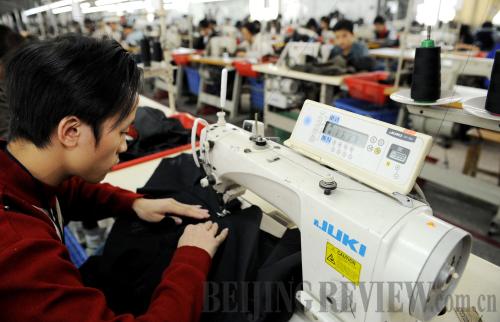|
 |
|
BETTER CLOTHING: Workers make clothing using computer-controlled machines at a Yishion clothing factory in Dongguan, Guangdong Province (XINHUA) |
Not wanting to return home a failure, Guo took the 50 yuan he had left and traveled to Guangzhou. Once in the provincial capital, Guo's luck took a turn for the better and he found a part-time job selling fruit by the dock. Waking early every morning, he would rush to the dock to prepare the fruit for sale, cleaning each piece and setting up his stall before other vendors arrived. Customer traffic was always heavy, especially since Guo was the only vendor ready to sell when the first shift of workers arrived.
With the fruit stall, Guo was able to save up money to pay the debt from the failed lumber venture, but he still wasn't satisfied with his current employment and social situation—so he went to night school and took business administration courses in his spare time. As exhausted as he would be after a day of manning the busy fruit stall, Guo never missed a class.
From fruit to fashion
Guo's transition from a fruit vendor to an apparel mogul happened almost completely by accident. After being introduced to someone in the apparel trade, Guo put his fruit peddling days behind him and started selling clothes he purchased from cheap clearance sales at various garment factories in the Pearl River Delta. For two years Guo and his newfound business partner visited almost every garment factory in the delta area, picking and choosing the best styles.
Even though he wasn't selling fruit, Guo had to wake up early to wait in front of factory gates to get the cheaper and more popular clothes. Once again Guo found himself looked down upon, not due to poverty, but because factory owners saw him as a garbage picker, ruffling through unwanted clothes.
Guo was unfazed. There had been, after all, a life worse than this—one filled with porridge and vegetables.
Profits were scarce, but Guo persisted. He was hooked by the apparel trade and began dabbling in the retail and wholesale business.
Guo learned the tricks of the garment trade quickly and put his brain into business mode to make his products stand out against similar competitors. One day, when other peddlers displayed all their best clothes, Guo took a different approach. He stuffed his clothes into bags with destination tags for Xi'an, Hangzhou, Ji'an and other cities across China. Passersby, many wholesale buyers, were curious about the garments that were apparently in hot demand and, after begging to look at the clothes, placed orders themselves.
For the first time, Guo Donglin felt the pride of having pockets full of bank notes. Luck seemed to finally be on his side, but he didn't stop there. He began focusing on an even more ambitious vision: an original line of clothes.
A brand of his own
Guo set up his first garment factory in Guangdong's Panyu City in 1996. That same year he met his future wife, Ye Guiyan.
In 1997, the couple moved the factory to Humen Town of Dongguan City, one of China's garment production centers. Despite the thousands of clothing shops in Dongguan, the couple shied away from the conventional big-name competitors and focused on making more fashionable clothing for younger customers.
Guo was responsible for factory management and his wife took charge of garment design. The small factory of some 40 employees ran smoothly, producing an array of garment styles in a short period of time.
The next step was finding buyers and creating a customer base. Guo took 11 originally designed pieces of clothing to the Second Humen International Fashion Fair and was welcomed with a pile of orders. Later, with two seats at the local Fumin fabric market, Guo began attracting buyers from across China. Guo's clothing grew in popularity day by day. Sales rocketed and on his best single day, 70,000 pieces were sold out.
Two years later, at the 1999 Humen International Fashion Fair, Guo focused on promoting his newly established brand, Yishion, as opposed to just taking garment orders. Wholesale manufacturing alone made limited economic returns to Guo, and he wanted to try his hand at running exclusive retail and franchise stores.
The next year Guo officially registered his company and launched his Yishion brand. It began to gain popularity, and in 2002 Yishion was voted as one of the top 10 leisure apparel brands by Chinese customers.
Guo's success story has served as an example for others in the garment industry. But Guo isn't worried about competition any time soon—for now he's preoccupied with steadily making his brand reach the primary market all over the country. | 